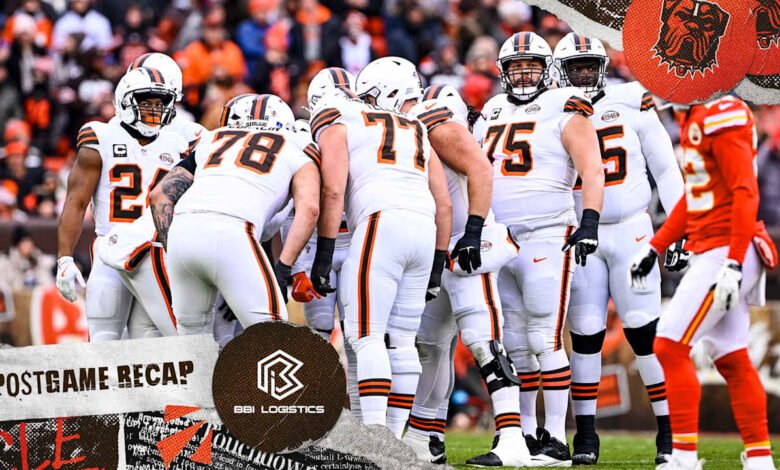Kansas City Chiefs vs Cleveland Browns Match Player Stats

Introduction to the Kansas City Chiefs vs Cleveland Browns Match
The Kansas City Chiefs vs Cleveland Browns Match Player Stats have a rich history and an intriguing rivalry that captures the attention of NFL fans. Historically, these two teams have faced off numerous times, with each matchup reflecting the evolution of their on-field strategies and player developments. The Chiefs, known for their explosive offense led by star quarterback Patrick Mahomes, have become a formidable force in the league, particularly in recent seasons. In contrast, the Browns, who have made significant strides in rebuilding their roster, boast a talented team that has consistently improved under head coach Kevin Stefanski.
As these teams prepare to clash, the recent performance trends of both squads add an additional layer of complexity to their matchup. The Chiefs have maintained a level of consistency with their potent attacking lineup, while the Browns have shown resilience and adaptability, often pushing their opponents to the limit. Understanding these dynamics is essential in appreciating the overall significance of the Kansas City Chiefs vs Cleveland Browns match.
Analyzing player stats plays a crucial role in dissecting the strategies employed by both teams. Significant metrics, ranging from quarterback ratings to offensive and defensive rankings, provide insights into how well each team can execute their game plan. The statistics derived from past encounters between the Kansas City Chiefs and Cleveland Browns offer valuable context, highlighting standout performances and critical moments that defined prior matchups. By evaluating individual and team performance, fans and analysts alike can garner a deeper understanding of what to expect in upcoming games, especially when considering the implications of momentum and in-game adjustments.
Key Players Overview
The Kansas City Chiefs and Cleveland Browns, two teams with strong aspirations in the NFL, rely heavily on their respective key players to drive their performance. In the case of the Chiefs, quarterback Patrick Mahomes is undeniably a central figure. Known for his extraordinary arm strength and athleticism, Mahomes has consistently delivered remarkable performances. His ability to extend plays and make decisive throws is essential for the Chiefs’ offensive strategy. Over the past few seasons, Mahomes has established himself among the elite quarterbacks in the league, setting high expectations for the upcoming Kansas City Chiefs vs Cleveland Browns match player stats.
On the offensive side for the Browns, Nick Chubb stands out as a pivotal player. As the starting running back, Chubb showcases impressive speed and power, making him a formidable force on the ground. His ability to gain yards after contact and break tackles will be integral for the Browns’ game plan. Chubb’s prior performances highlight his consistency and effectiveness, which will play a crucial role in how the Browns manage their offense during the matchup against the Chiefs.
Each defense will also have key players to watch. For the Chiefs, defensive lineman Chris Jones is central to their defensive scheme. Jones’ ability to disrupt offensive lines and pressure quarterbacks can change the momentum of a game. He plays a significant role in stopping the run and pressuring the opposing quarterback, making his contributions vital in the Kansas City Chiefs vs Cleveland Browns match player stats. Meanwhile, the Browns boast a standout linebacker in Myles Garrett. Renowned for his quickness and tackling ability, Garrett is a critical component of the Browns’ defense, often tasked with key challenges during crucial downs.
Overall, the performances of these key players are expected to leave a lasting impact on the outcome of the match and set the tone for future games, underscoring the importance of analyzing their statistics as the game unfolds.
Offensive Player Stats Comparison
The offensive player statistics from the Kansas City Chiefs vs Cleveland Browns match provide valuable insights into the performance of both teams. Analyzing these stats, which include passing, rushing, and receiving yards, reveals the strengths and weaknesses of each offense during this competitive encounter. For the Chiefs, quarterback Patrick Mahomes showcased his exceptional passing skills, accumulating significant yardage throughout the game. He demonstrated precise throws and effective decision-making, contributing to the Chiefs’ offensive rhythm. In contrast, the Browns’ Baker Mayfield aimed to establish a strong offensive presence, yet faced challenges against the Chiefs’ defensive unit, leading to inconsistent passing numbers.
Rushing yards are another critical aspect of the offensive stats. The Chiefs relied heavily on their dynamic running backs, resulting in a balanced offensive strategy that kept the Browns’ defense on their toes. Clyde Edwards-Helaire, in particular, had standout moments, breaking tackles and gaining substantial yards after contact. Meanwhile, the Browns aimed to maximize their ground game with Nick Chubb, known for his powerful running style. Although he had moments of success, the Chiefs’ defense managed to limit his big plays, impacting the overall flow of the game.
Receiving yards further illustrate the offensive capabilities of both teams. The Chiefs featured a talented wide receiver corps, including Tyreek Hill and Travis Kelce, who consistently found openings in the Browns’ coverage. Their ability to gain crucial yards after the catch highlighted their impact on offensive drives. Conversely, the Browns faced difficulties in connecting with their playmakers, as Jarvis Landry and Odell Beckham Jr. struggled to make significant contributions under pressure. These variabilities in offensive player stats ultimately influenced how each team approached their strategy, indicating potential adjustments for future matchups.
Defensive Player Stats Comparison
In analyzing the defensive player statistics from the recent Kansas City Chiefs vs Cleveland Browns match, several key figures emerge that accentuate the strengths and weaknesses of both teams. The role of defense in football cannot be underestimated, as it often plays a critical part in determining the outcome of tight match-ups. Defensive stats, including tackles, sacks, and interceptions, provide valuable insights into each team’s capabilities and strategies.
The Kansas City Chiefs showcased formidable defensive prowess, boasting players who excelled in both solo and assisted tackles. For instance, linebacker Nick Bolton recorded an impressive number of tackles, illustrating his ability to read plays and put himself in optimal positions. Additionally, the Chiefs’ defensive line contributed significantly by generating pressure on the quarterback, highlighted by Chris Jones’ notable sack count. His ability to disrupt plays not only affects the quarterback’s rhythm but also creates opportunities for turnovers.
On the other hand, the Cleveland Browns had standout performances within their defensive unit as well. Defensive end Myles Garrett emerged as a key force, known for his ability to pressure quarterbacks and create havoc in the backfield. Garrett’s statistics reflected a high number of tackles combined with multiple sacks, emphasizing his role in the Browns’ defensive strategy. Furthermore, the secondary showcased resilience, with cornerback Denzel Ward contributing interceptions that led to crucial changes in possession during the game.
By juxtaposing the defensive player stats from the Kansas City Chiefs vs Cleveland Browns match, one can discern that while both teams possess strong defensive players capable of making significant plays, variations in tackling efficiency and turnover generation played a vital role in shaping the match dynamics. Ultimately, these defensive statistics are instrumental in evaluating how each team prepares to confront challenges in both the present and future games.
Quarterback Performance Metrics
The quarterback position often serves as a pivotal factor in the outcome of any football game, particularly evident in the Kansas City Chiefs vs Cleveland Browns matchup. Analyzing the performance of both starting quarterbacks reveals critical insights into how their play may influence the final score. Two primary metrics that are essential for evaluating quarterback effectiveness are completion percentage and touchdown-to-interception ratios.
Completion percentage indicates how successful a quarterback is at converting passes into completions. A high percentage signifies accuracy and the ability to maintain offensive momentum, while a lower percentage could hint at struggles against the opposing defense. For instance, if the Kansas City Chiefs quarterback achieves a completion rate of over 65%, it suggests strong precision, which could result in sustained drives and increased opportunities to score. In contrast, the Browns’ quarterback must also aim for a high completion percentage to remain competitive, as even marginal differences can significantly impact the game dynamics.
Touchdown-to-interception ratios further elaborate on a quarterback’s overall performance. A favorable ratio means the player effectively leads the offense while minimizing turnovers, which are critical in close matches. A ratio of 3:1 suggests that the quarterback not only finds the end zone but also limits mistakes. In the Kansas City Chiefs vs Cleveland Browns matchup, the performance of the starting quarterbacks will likely determine field position and scoring opportunities. Additionally, the pressure experienced by the quarterbacks during the game—the number of hitting or hurried throws—can heavily influence these metrics. A quarterback under duress is likely to perform below standards, resulting in lower completion percentages and poorer scoring efficiency.
Overall, evaluating these quarterback performance metrics provides a deeper understanding of how the game may unfold and the potential factors that could sway the Kansas City Chiefs vs Cleveland Browns match outcome.
Game-Changing Plays and Player Impact
The match between the Kansas City Chiefs vs Cleveland Browns Match Player Stats showcased a variety of game-changing plays that significantly influenced the outcome. Players from both teams demonstrated exceptional skill and determination, with key contributions that reverberated throughout the contest. One of the standout performances came from the Chiefs’ quarterback, who consistently executed pivotal passes, earning impressive completion percentages. His ability to read the defense was crucial in moving the chains during critical moments of the game.
On the other side, the Browns’ defense delivered several notable plays that shifted momentum. For instance, a well-timed interception late in the second quarter not only halted a promising Chiefs’ drive but also energized the Browns, leading to a quick score. This particular play illustrated how individual defensive efforts can create significant impact, turning the tide in favor of the Browns during an otherwise dominant performance by Kansas City.
In terms of player statistics, the running backs from both teams played a substantial role in maintaining offensive balance. The Kansas City Chiefs’ lead back recorded a noteworthy number of rushing yards, effectively complementing the aerial attack. Conversely, the Browns’ running game also showed resilience, with key conversions during critical third down scenarios. These statistics are not just numbers; they represent the grit and strategy behind each play that kept viewers on the edge of their seats.
Throughout the contest, each significant moment—from a last-minute touchdown pass to a crucial stop on fourth down—revealed the intricate dance of player influence that ultimately determined the game’s victor. The Kansas City Chiefs vs Cleveland Browns match player stats serve as a testament to how individual efforts culminate in the broader narrative of football, ensuring that each game tells its own unique story.
Coaching Strategies and Player Stats Correlation
The Kansas City Chiefs and Cleveland Browns have established unique coaching strategies that directly influence player statistics during their matchups. The Chiefs, led by head coach Andy Reid, emphasize an aggressive offensive approach, focusing on high-tempo plays and maintaining a versatile passing game. This is evident in their player stats, particularly for key athletes like Patrick Mahomes and Travis Kelce, who thrive in an environment that encourages dynamic role flexibility. Reid’s ability to adapt plays based on defensive setups has often led to impressive player performances, as seen in previous seasons’ matchups.
Conversely, the Cleveland Browns, under head coach Kevin Stefanski, apply a more balanced and methodical approach. With a strong emphasis on the run game, Stefanski’s strategies often allow players such as Nick Chubb to excel statistically, capitalizing on both designed runs and play-action opportunities. This dual-threat approach not only opens up lanes for their running backs but also creates favorable matchups for receivers like Amari Cooper. Adjustments made during the game, such as increasing the passing attempts in response to Kansas City’s high-scoring offense, can significantly elevate the performance metrics across the board.
During the faceoff between the Kansas City Chiefs and Cleveland Browns, tactical adjustments are frequently made to optimize player efficiency. For instance, if the Chiefs employ a heavy pass rush, the Browns might counteract by utilizing quick-release plays or more screen passes. Such real-time strategies have proven to alter player stats significantly, allowing teams to exploit vulnerabilities in their opponent’s game plan. The immediate responsiveness of the coaches and the ability to pivot strategies based on situational performance exemplify the integral correlation between coaching decisions and player statistics in these critical matchups.
Injury Impact on Player Stats
In any competitive sport, injuries can significantly alter the course of a season and the performance of individual players. The recent Kansas City Chiefs vs Cleveland Browns match vividly illustrated this dynamic. Injuries to key players can drastically affect team strategies and overall statistics. For instance, the absence of a star quarterback often leads to a reliance on backup players who may have less experience or different skill sets. This adjustment typically results in changes in play-calling and strategic execution, ultimately impacting the available player stats.
During the matchup between the Kansas City Chiefs and the Cleveland Browns, injuries were a crucial factor in the performance of both teams. The Chiefs were particularly affected by a key injury to one of their prime offensive players. This not only disrupted their typical offensive flow, but also placed greater scrutiny on their backup players to step up rapidly. Conversely, the Browns also dealt with injuries that influenced their defensive schemes, compelling them to adjust their tactics to compensate for missing personnel. As players were shuffled into unfamiliar roles, it became clear that the statistics would reflect these changes.
The role of backups cannot be overstated in such scenarios. When a starter is sidelined, the performance of the substitute players becomes critical, and their ability to perform under pressure can be a decisive factor in the match outcome. During the Chiefs vs Browns game, players who traditionally occupied lesser roles were thrust into prominent positions, affecting their individual player stats and influencing team dynamics. These situations highlight the challenges teams face in managing injuries and the importance of depth in their rosters. Effective strategic adaptations and the capacity of backups to deliver when needed can make the difference between winning and losing.
Looking Ahead: Future Matchups and Player Development
The Kansas City Chiefs vs Cleveland Browns match showcased significant performances that not only highlighted the current state of both teams but also set the stage for their future matchups and the development of individual players. As each season progresses, the impact of player statistics from key games can influence decisions regarding trades, drafts, and overall team strategy.
For the Kansas City Chiefs, standout players from this matchup are likely to be evaluated for their potential in upcoming games. Exceptional stats may enhance their trade value or solidify their roles within the team’s roster. Maintaining a competitive edge requires understanding which players can consistently contribute, and this match provided valuable data for that analysis. Should certain Chiefs players continue to show growth or consistency, it could lead to a more robust team dynamic as the season progresses.
Conversely, the Cleveland Browns will need to reflect on their performance metrics during this encounter. Recognizing which players underperformed versus their standard can inform their approach to potential trades as they may seek to either enhance their current lineup or develop young talent. The future of these players hinges on their ability to adapt and improve based on their match stats. Moreover, the Browns may prioritize drafts focused on addressing weaknesses exposed in this matchup, thus facilitating team growth.
Overall, the outcomes from the Kansas City Chiefs vs Cleveland Browns match player stats will reverberate throughout both franchises. Coaches and management will use these insights to shape their future strategies and player development initiatives, ensuring that both teams position themselves for success in the coming seasons.
You May Also Read This Skyrix.



